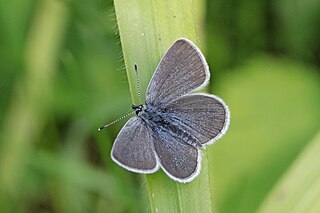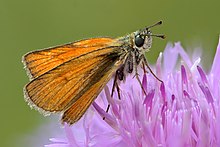
Thymelicus lineola, known in Europe as the Essex skipper and in North America as the European skipper, is a species of butterfly in the family Hesperiidae.

The Lulworth skipper is a butterfly of the family Hesperiidae. Its name is derived from Lulworth Cove in the county of Dorset, England, where the first specimens in Great Britain were collected in 1832 by English naturalist James Charles Dale.

The large skipper is a butterfly of the family Hesperiidae.

The dingy skipper is a species of butterfly in the family Hesperiidae.

The small blue is a Palearctic butterfly in the family Lycaenidae. Despite its common name, it is not particularly blue. The male has some bluish suffusion at the base of its upper wings but is mostly dark brown like the female. The species can live in colonies of up to several hundred and in its caterpillar stage is cannibalistic.

The pearl-bordered fritillary is a butterfly of the family Nymphalidae found in Europe and through Russia across the Palearctic to the north of Kazakhstan.

The heath fritillary is a butterfly of the family Nymphalidae. It is found throughout the Palaearctic from western Europe to Japan, in heathland, grassland, and in coppiced woodland. Its association with coppiced woodland earned it the name "woodman's follower" in parts of the UK. It is considered a threatened species in the UK and Germany, but not Europe-wide or globally.

Holcus mollis, known as creeping soft grass or creeping velvet grass, is a species of grass, native to Europe and western Asia.

Talicada nyseus, the red Pierrot, is a small but striking butterfly found in the Indian subcontinent and South-East Asia belonging to the lycaenids, or blues family. The red Pierrots, often found perching on its larva host plant, Kalanchoe, are usually noticed due to their striking patterns and colors.

Ancistroides folus, the grass demon, is a small but prominent butterfly found in India & Nepal that belongs to the skipper family, Hesperiidae. It is regarded as an occasional pest of ginger and turmeric plants.

Spialia galba, the Indian grizzled skipper, is a hesperiid butterfly which is found in South Asia and parts of Southeast Asia.

Hesperia dacotae, the Dakota skipper, is a small to medium-sized North American butterfly. It has a wingspan of approximately one inch and the antennae form a hook. The male's wings are a tawny-orange to brown on the forewings with a prominent mark and dusty yellow on the lower part of the wing. The female wing is a darker brown orange and white spots on the forewing margin.

The Zabulon skipper is a North American butterfly first described by the French naturalists Jean Baptiste Boisduval and John Eatton Le Conte from the state of Georgia, United States.

Atalopedes campestris is a small grass skipper butterfly. It has a wingspan of 35–41 mm. Male is orange, edged with brown, and has a large brown-black stigma. Female is darker with lighter markings in the center of the wing.

Carcharodus alceae, commnly known as the mallow skipper, is a species of butterfly of the family Hesperiidae.

Ancyloxypha numitor, the least skipper, is a North American butterfly in the family Hesperiidae. They have a weak, Satyrinae-like flight.
Agathymus neumoegeni is commonly referred to as the orange giant-skipper, Neumogen's giant-skipper, Neumogen's agave borer, Neumogen's moth-skipper, and tawny giant-skipper.

Muschampia floccifera, the tufted skipper or tufted marbled skipper, is a butterfly of the family Hesperiidae.

Carterocephalus palaemon, the chequered skipper or arctic skipper, not to be confused with the large chequered skipper, is a species of woodland butterfly in the family Hesperiidae. This butterfly can live in grasslands. The upperside of the butterfly is brown with orange spots and on its underside the chequered skipper is orange with brown spots. Chequered skippers are found in Great Britain and other European regions, but seen locally in Japan and in North America. The size of the chequered skipper ranges from 19 to 32 mm with females being larger. In the 1970s, the chequered skipper went extinct in England due to the new management of the woodlands.





















